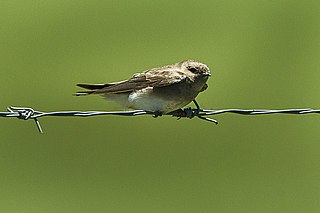
The wheatears are passerine birds of the genus Oenanthe. They were formerly considered to be members of the thrush family, Turdidae, but are now more commonly placed in the flycatcher family, Muscicapidae. This is an Old World group, but the northern wheatear has established a foothold in eastern Canada and Greenland and in western Canada and Alaska.

The northern wheatear or wheatear is a small passerine bird that was formerly classed as a member of the thrush family Turdidae, but is now more generally considered to be an Old World flycatcher, Muscicapidae. It is the most widespread member of the wheatear genus Oenanthe in Europe and North and Central Asia.

The Old World flycatchers are a large family, the Muscicapidae, of small passerine birds restricted to the Old World, with the exception of several vagrants and two species, bluethroat and northern wheatear, found also in North America. These are mainly small arboreal insectivores, many of which, as the name implies, take their prey on the wing. The family is relatively large and includes 357 species, which are divided into 54 genera.

The blue rock thrush is a species of chat. This thrush-like Old World flycatcher was formerly placed in the family Turdidae. It breeds in southern Europe, northwest Africa, and from Central Asia to northern China and Malaysia. The blue rock thrush is the official national bird of Malta and was shown on the Lm 1 coins that were part of the country's former currency.

The brown-throated martin or brown-throated sand martin is a small passerine bird in the swallow family, Hirundinidae, that is widely distributed across Africa. It was formerly regarded as conspecific with the grey-throated martin and the Madagascar martin.

The blackstart is a chat found in desert regions in North Africa, the Middle East and the Arabian Peninsula. It is resident throughout its range.

The mountain chat or mountain wheatear is a small insectivorous passerine bird that is endemic to southwestern Africa.

The brown rock chat or Indian chat is a bird species of the family Muscicapidae. It is found mainly in northern and central India. It is often found on old buildings and rocky areas. It resembles a female Indian robin but lacks the reddish vent and differs in posture and behaviour apart from being larger. In flight it bears some resemblance to thrushes and redstarts. It feeds on insects, captured mainly on the ground. It was formerly placed as the sole species in the genus Cercomela but is now included with the wheatears in the genus Oenanthe.

The tractrac chat is a small passerine bird of the Old World flycatcher family Muscicapidae. It is a common resident breeder in southernmost Angola, western Namibia and western South Africa.

The Karoo chat is a small passerine bird of the Old World flycatcher family Muscicapidae. It is a common resident breeder in southwesternmost Angola, western Namibia and western South Africa. Its habitat is Karoo and desert scrub in the south, extending to the escarpment zone in the north.

The sickle-winged chat or sicklewing chat is a small passerine bird of the Old World flycatcher family Muscicapidae endemic to southern Africa. It is a common resident breeder in South Africa and Lesotho, and is also found in southernmost areas of Botswana and Namibia. Its habitat is Karoo scrub, short grassland, and barren sandy or stony areas. In western coastal areas, it also occurs on agricultural land.

The moorland chat, also known as the alpine chat or hill chat, is a species of songbird in the Old World flycatcher family. It is endemic to north-east Africa where it is common in its habitat. It lives at high altitudes on moors and grassland, usually above 3,400 m (11,100 ft), but can live as low as 2,100 m (6,900 ft). It has a short tail and long legs. It is bold and will approach people.
The sombre rock chat is a species of passerine bird in the family Muscicapidae. It is native to montane desert of central Ethiopia and possibly far-western Somalia. Its natural habitat is subtropical or tropical dry shrubland.
The brown-tailed rock chat is a species of bird in the family Muscicapidae. It is found in Chad, Eritrea, Ethiopia, Kenya, Somalia, Sudan, and Uganda. Its natural habitats are dry savanna and subtropical or tropical dry shrubland.

The Himalayan rubythroat is a species of passerine bird in the family Muscicapidae. It is closely related to the Siberian rubythroat which however lacks the distinctive white tail-tips and white tail bases. It was also previously considered conspecific with the Chinese rubythroat, together called the white-tailed rubythroat. It is found along the Tien Shan and Himalayan ranges from Afghanistan to Myanmar. Three subspecies are recognized across its wide range.

The ashy flycatcher is a species of bird in the Old World flycatcher family Muscicapidae. It is found throughout sub-Saharan Africa, excluding the drier areas of South Africa, Botswana, and Namibia, where it inhabits subtropical or tropical dry forest, subtropical or tropical moist lowland forest, and savanna. It has a disputed generic placement, with different authorities variously putting it in Muscicapa, Fraseria, or other genera. Ashy flycatchers are mostly grey in colour, with pale grey or white underparts, and display no sexual dimorphism.

The white-fronted black chat is a species of passerine bird in the family Muscicapidae. It is native to the Sudan (region). Its natural habitats are moist savanna and subtropical or tropical dry shrubland.

Hume's wheatear is a species of bird in the Old World flycatcher family Muscicapidae. This black-and-white bird is found in southern Afghanistan, Iran, extreme northeast Iraq, Oman, Pakistan, Qatar and the United Arab Emirates.

Chamaetylas is a genus of small, mainly insectivorous birds in the Old World flycatcher family Muscicapidae that are native to sub-Saharan Africa.

Emarginata is a genus of birds in the Old World flycatcher family Muscicapidae that occur in southern Africa.






















